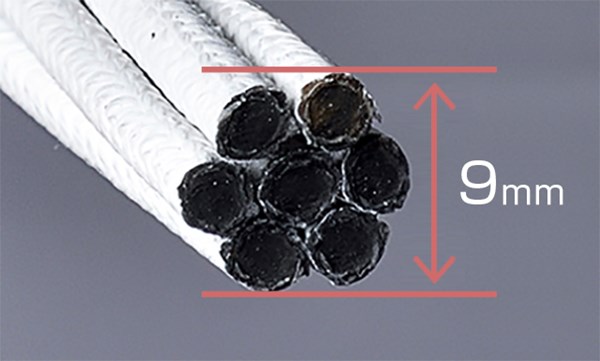Carbon fiber performs aesthetically and structurally
From the informative website called Composites and Architecture, hosted by Kreysler and Associates (American Canyon, CA, US), comes a unique use of carbon fiber strands.

Komatsu Seiren's building in Japan with carbon fiber strands as seismic reinforcement.
For readers who don’t know, there’s a highly interesting and informative website called Composites and Architecture, hosted by Kreysler and Associates (American Canyon, CA, US). If you don’t know Kreysler and Associates, you should — they are a leader in getting composite materials into construction and architectural applications, and we’ve written about their projects on many occasions (here’s two articles: http://www.compositesworld.com/articles/sfmoma-faade-advancing-the-art-of-high-rise-frp; http://www.compositesworld.com/articles/residential-construction-breakthrough-composites-find-a-home).
The aforementioned web site is an eclectic assortment of composites’ use in exteriors, interiors, furniture, sculpture, and new material technology. A recent post involves Japanese textile manufacturer Komatsu Seiren (Ishikawa, Japan), a maker of a variety of fabrics, including some advanced materials. They recently undertook the renovation of their former head office building, with the goal of creating exhibition, museum, office and laboratory spaces, including a rooftop terrace. Project architect Kengo Kuma, interviewed in a video on the Komatsu Seiren web site, wanted to show both the high strength and the lightness and delicacy of carbon fiber strands, using Komatsu Seiren’s own Cabkoma strand rod, developed and manufactured at the facility starting in 2010.
Cabkoma comprises carbon fiber tow that is encapsulated by a sheath of glass or aramid fiber, wet out with a thermoplastic matrix. Seven coated tows are bundled and twisted together to form a single flexible rod, white in color. The company claims the tensile strength of a 5.83mm diameter rod is 38.22 kN (8,592 lbs), or 1.43 kN/mm2 (207,350 psi). The rods are considerably smaller in diameter, and lighter in weight, than steel reinforcement of equal strength; a 160-meter coil of the rod weighs just 12 kg (26.5 lbs). For the rehab and seismic project, the rods were inserted and adhesively bonded into end fittings called rod bearing jigs for attachment to a rooftop anchor structure and into the ground, around the exterior perimeter of the building. They were also used to bolster seismic resistance within the interior, notably, forming lattice shear walls between building columns, with rods oriented at 45° angles.

Closeup of the Cabkoma rod product, from the Komatsu Seiren web site.
In effect, the building's exterior has been “wrapped” by hundreds of spaced Cabkoma rods or strands, that almost resemble a sheer undulating fabric. The result is an airy, organic façade that has a fabric-like aesthetic (true to the building’s purpose) while still offering the strength to resist ground motion during an earthquake event.
Kuma says in the video that the project was a challenge, solvable only with today’s computers, to determine how many rods were necessary and how to best accomplish the seismic reinforcement needed (in addition to conventional earthquake reinforcement installed in the building as required by Japanese building code). He believes the rod will “change things” and has the potential to create a major revolution in the world of construction.
Watch the video interview with Kengo Kuma about the building reinforced with Cabkoma strands. Kuma is a well-known Japanese architect and professor at the Graduate School of Architecture at the University of Tokyo: http://www.komatsuseiren.co.jp/cabkoma/en/index.html.
Related Content
Recycling end-of-life composite parts: New methods, markets
From infrastructure solutions to consumer products, Polish recycler Anmet and Netherlands-based researchers are developing new methods for repurposing wind turbine blades and other composite parts.
Read MoreCryo-compressed hydrogen, the best solution for storage and refueling stations?
Cryomotive’s CRYOGAS solution claims the highest storage density, lowest refueling cost and widest operating range without H2 losses while using one-fifth the carbon fiber required in compressed gas tanks.
Read MoreInfinite Composites: Type V tanks for space, hydrogen, automotive and more
After a decade of proving its linerless, weight-saving composite tanks with NASA and more than 30 aerospace companies, this CryoSphere pioneer is scaling for growth in commercial space and sustainable transportation on Earth.
Read MoreThe lessons behind OceanGate
Carbon fiber composites faced much criticism in the wake of the OceanGate submersible accident. CW’s publisher Jeff Sloan explains that it’s not that simple.
Read MoreRead Next
“Structured air” TPS safeguards composite structures
Powered by an 85% air/15% pure polyimide aerogel, Blueshift’s novel material system protects structures during transient thermal events from -200°C to beyond 2400°C for rockets, battery boxes and more.
Read MoreVIDEO: High-volume processing for fiberglass components
Cannon Ergos, a company specializing in high-ton presses and equipment for composites fabrication and plastics processing, displayed automotive and industrial components at CAMX 2024.
Read MoreAll-recycled, needle-punched nonwoven CFRP slashes carbon footprint of Formula 2 seat
Dallara and Tenowo collaborate to produce a race-ready Formula 2 seat using recycled carbon fiber, reducing CO2 emissions by 97.5% compared to virgin materials.
Read More






















